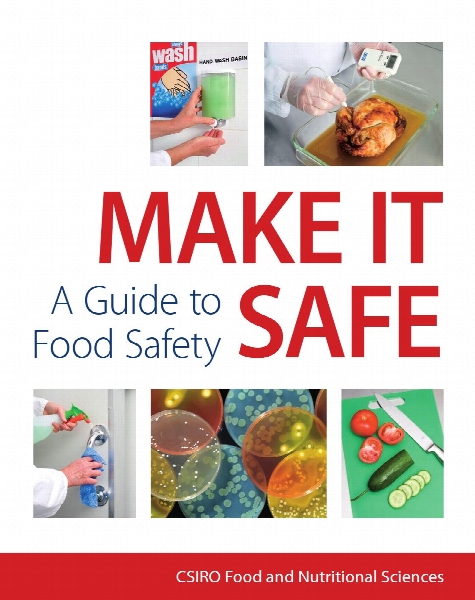Make it safe! : a guide to food safety.
- نوع فایل : کتاب
- زبان : انگلیسی
- مؤلف : CSIRO (Australia). Food and Nutritional Sciences.
- ناشر : Collingwood, Vic. : CSIRO Publishing
- چاپ و سال / کشور: 2010
- شابک / ISBN : 9780643095687
Description
Chapter 1 Why is food safety your concern? 1 What are the food safety hazards you should know about? 1 Microbial hazards 1 Chemical hazards 3 Physical hazards 4 Taking responsibility for food safety – it’s the Law 5 The Australia New Zealand food standards system 5 The benefits of taking food safety issues seriously 9 Health and wellbeing of your customers 11 Viability and growth of your business 13 Continued popularity of products in your industry sector 15 Minimising the overall cost to society 16 Protecting the reputation of Australia’s food industry 17 Key messages from Chapter 1 19 Chapter 2 Food safety hazards – under the spotlight 21 Microbial hazards – pathogenic microorganisms and their toxins 21 Pathogenic foodborne bacteria 22 Pathogenic foodborne viruses 34 Parasites 36 Chemicals – environmental contaminants, food business use or naturally occurring 38 Government regulations and monitoring 38 Chemicals hazards in food businesses 39 Naturally occurring substances 43 Physical contaminants in food 50 Key messages from Chapter 2 53Chapter 3 Controlling food safety hazards – premises and people 55 Food business premises and equipment 55 Safe products cannot be made in an unsafe environment 55 Fit-for-purpose equipment 67 Cleaning and sanitising 78 Pest control and animal exclusion 91 Food safety – the responsibility of all who operate or work for a food business 96 Staff experience and training 96 The health of food handlers 98 Food hygiene essentials 101 Key messages from Chapter 3 111 Chapter 4 Controlling food safety hazards – your product recipes 113 Adding acid to food 113 Reducing the available water in food 120 When to measure pH and water activity 122 Adding chemical preservatives 123 Nitrites and nitrates 123 Nisin 124 Sulphur dioxide and sulphites 125 Combining hurdles to control pathogenic microorganisms 126 Key messages from Chapter 4 129 Chapter 5 Controlling food safety hazards – your ingredients 131 Purchasing your ingredients 131 Purchasing from a supplier – approved supplier programs 131 Regulatory requirements and product specifications 133 Steps to follow when receiving deliveries 137 Goods receipt form 138 Overview of what to check for 140 Checking the temperature of potentially hazardous foods 141 Checking food for adequate protection against contamination 145 Traceability 145 Use of your own vehicles when purchasing ingredients 146 Storing your ingredients safely 147Recommended storage practices for different food categories 149 Food storage containers and covers 153 Re-packing and portioning bulk ingredients 155 Stock rotation 155 Separation of rejected or discarded foods 156 Key messages from Chapter 5 159 Chapter 6 Controlling food safety hazards – preparing, cooking and cooling safely 161 The planning phase – it pays to think before you make 161 Basic steps for safely preparing food 161 Chilling as you go 163 Washing and sanitising fruit and vegetables 163 Thawing frozen foods 165 Food preparation equipment 166 Labelling and keeping track of individual components 167 Making unplanned changes 167 Clearing and cleaning as you go 168 Preparing products containing food allergens 168 Cooking – some like it hot, but not pathogens … 169 Commercial sterilisation 170 Measuring the temperature of food 173 Pasteurisation 178 Cooling – now your product is hot you must cool it down … carefully 188 Reducing portion sizes before chilling 189 Chilling equipment 189 Chilling in appropriate containers 191 Freezing post pasteurisation 192 Chilling without a prior cooking step 193 Microbiological testing provides important evidence 193 Key messages from Chapter 6 195 Chapter 7 Controlling food safety hazards – packaging, shelf-life and labelling 197 Packaging your products 197 Packaging materials 198Purchasing packaging 200 Caring for packaging materials 202 Temperature control during packaging 204 Controlling the atmosphere around food 204 Packaging and heat processed products 207 Packaging seals and closures 209 Secondary and tertiary packaging 214 Using contract packers 214 Product shelf-life and food safety 216 Do your products require a use-by or best-before date? 217 Determining appropriate use-by dates: in house 219 Determining appropriate use-by dates: technical experts 220 Labelling your products 224 Mandatory statements and declarations 224 Product traceability 229 Directions for use and storage 230 Legibility of writing on labels 234 Minimum recommended labelling 235 Requirements for unlabelled products 236 Key messages from Chapter 7 237 Chapter 8 What if something goes wrong? 239 Food recalls – overview and definitions 239 Reasons for food recalls 239 Legal obligations 240 Initiation of recalls 240 Levels of recalls 241 Priorities in the recall process 242 Notification and reporting requirements 243 An effective recall requires fast facts 246 Retrieval of recalled products 246 The fate of recalled products 246 Writing a recall plan 247 Roles and responsibilities 247 Notification procedures and contact details 248 Access to production and distribution records 249Product retrieval and disposal 250 Trialling and reviewing the recall plan 250 Key messages from Chapter 8 251 Chapter 9 Food microbiology: further facts 253 Sources of information 269 Useful contacts 275 Glossary 279


